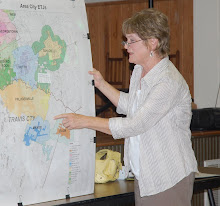“ACRE” includes anti-rail expansion through our area
Several years ago, ACRE began in Coupland as the Anti-Corridor/Rail Expansion group. For the most part, our focus has been on the “Anti-Corridor” part. More has been going on with the Trans-Texas Corridor than with “Rail,” with the exception of some discussion of the rail portion of the Corridor.
TxDOT proposes expanding rail through Coupland area
However, now a report has come out that deals with rail routes in our Coupland area. At the end of July, TxDOT released the Central Texas Rail Relocation Study.
To see the entire report, go to: ftp://ftp.dot.state.tx.us/pub/txdot-info/tpp/ctr_rail_study.pdf
The Study contains 147 pages with detailed maps and a letter from Union Pacific at the end.
Once again, people who live elsewhere have thought of another use for our land. They want to move UP’s freight rail from the line in Austin through our valuable farmland so that they can put commuter rail on the line in Austin. It is beside the point that very few will use this commuter rail because of the arrangement and dispersion of our population and our preference for personal transportation. This does not matter to those who would line the pockets of contractors and elevate officials and bureaucrats through the construction of new or expanded rail lines through our area and of the new commuter line.
No power or money to move the freight rail right now
I don’t want to alarm residents in our area. The alternative routes that are in this Study would cause disruption, but so far, there is no power and no money to move this freight rail. We in our area need to be aware of what is in this Study because both of the proposed changes in freight rail begin at Taylor.
Taylor and Coupland affected
There are two main alternatives discussed in this Study. One is to upgrade UP’s existing route beginning in Taylor, going through Coupland, and on to Elgin and Bastrop. The second is an entirely new route going from Taylor to San Antonio.
Taylor would be affected by route changes as seen on the map entitled Figure 1-1 that is the 121st page in the Study document. Expanding the existing line going south would involve changes in how the line is connected in Taylor and changes in curves south of Taylor. Building a new route between Taylor and San Antonio (the Austin Bypass) would involve a new line leaving existing rail east of Taylor and cutting a diagonal line toward the southwest, south of Taylor.
Expanding the existing route through Coupland
Coupland residents need to know that the Report says:
“An overpass for FM 1466 is proposed in Coupland. Coupland is a small
community and the main business district is located along FM 1466 and only a
few hundred feet away from the railroad (Figure 1-1). Elevating FM 1466
through this area will have a significant impact to access to the businesses.
Further study is needed to determine if a grade separation is feasible at this
location.”
The map Figure 1-1 on the 121st page of the document notes the proposed overpass at Coupland.
Austin Bypass
The alternative other than expanding through Coupland is called the direct Austin Bypass. It is a totally new route, moving the freight rail from Austin to the southwest of Taylor and west of Coupland.
Study is a presentation of possibilities
I want to emphasize that there is no definite plan for any of the alternatives in this report. First, there is no money. The July 31 Statesman article by Ben Wear says, “[I]t remains unclear how either the state or Central Texas governments will raise the money for the freight line bypass or the commuter line.” The TxDOT engineer in charge of the study said, “The biggest obstacle is funding.”
One possibility for funding is a rail relocation fund approved by state voters in 2005. Our Coupland voters and many other rural districts around the state voted against this rail relocation fund. (Some may remember Sylvia Summers and me standing outside Coupland School holding signs against this rail fund. Thanks for your support!) So far, this fund is unfunded; the commuter rail proponents hope to convince legislators to put money into it.
Union Pacific doesn’t want to move and doesn’t have to
Union Pacific is not pushing this project. When UP’s Joe Arbona spoke in Coupland, he said that UP was happy with its current routes. The state can’t force UP, which is regulated by the federal government, to do anything. The Central Texas Rail Relocation Study concludes, “UP, as a private industry, owns and operates on its existing facility and may be resistant to relocating to another corridor without adequate compensation.”
UP rejects Trans-Texas Corridor
UP also does not want its routes to be included in the Trans-Texas Corridor. “[W]e are opposed to any relocation of Union Pacific’s operations in the San Antonio-Austin area as a part of the Trans Texas Corridor. Inclusion of this corridor as part of the TTC project would limit both operation and commercial flexibility,” UP Vice President John Rebensdorf said in a letter to TxDOT. This letter from UP to TxDOT is on the last two pages of the Study.
Subscribe to:
Post Comments (Atom)

No comments:
Post a Comment